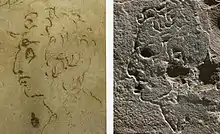| Importuno di Michelangelo | |
|---|---|
.jpg.webp) Profile of a man | |
| Artist | Attributed to Michelangelo |
| Location | Palazzo Vecchio, Florence |
The Importuno di Michelangelo ("The Nuisance by Michelangelo") is the profile of a man's head carved on the façade of Palazzo Vecchio in Florence, recently attributed to the artist Michelangelo Buonarroti by Adriano Marinazzo. This new hypothesis has been published in the Italian art magazine Art e Dossier.[1]
History
The reason for this profile is unknown. An old popular legend[2] links it to the artist Michelangelo.[3] He allegedly sculpted it to ridicule someone he found bothersome (hence Importuno di Michelangelo, "The Nuisance by Michelangelo").[4]
The new hypothesis
The new hypothesis on Michelangelo's possible involvement in the creation of the profile of Palazzo Vecchio is based on the strong resemblance of the latter to a profile drawn by Michelangelo in the early 16th century now at the Louvre. The profile was probably sculpted with the permission of the city authorities. The façade of Palazzo Vecchio was constantly guarded. Therefore its author enjoyed a certain consideration and freedom of action.[1]
The sculpted profile style is consistent with that of the head profiles drawn by Michelangelo in the early years of the 16th century. Consequently, the portrait of Palazzo Vecchio should also be dated to the beginning of the 16th century; its execution would coincide with the placement in 1504 of Michelangelo's David to the left of the Palazzo Vecchio's entrance.[5]

Reception
The new hypothesis received immediate attention from scholars and the international media. The Wall Street Journal reported this news on the front page "The attribution of a new Michelangelo would be significant, particularly one hiding in plain sight."[6] Further articles were published by Le Figaro,[7] The Telegraph,[8] Die Presse,[9] Smithsonian Magazine,[5] Artnet News,[10] and others.[11][12]
See also
References
- 1 2 Marinazzo, Adriano (2020). "Una nuova possible attribuzione a Michelangelo. Il Volto Misterioso". Art e Dossier. 379: 76–81. ISSN 0394-0179.
- ↑ ALESSANDRI, NORMA (14 December 2015). "Il ritratto nascosto di Michelangelo sulla facciata di Palazzo Vecchio". La Nazione (in Italian). Retrieved 2021-01-03.
- ↑ "The Legend Behind Michelangelo's Graffiti". ITALY Magazine. Retrieved 2021-01-03.
- ↑ Crow, Kelly (2020-11-13). "Was Michelangelo a Renaissance Banksy?". Wall Street Journal. ISSN 0099-9660. Retrieved 2021-01-02.
- 1 2 Davis-Marks, Isis. "Did Michelangelo Carve a Graffiti Portrait Into This Florentine Facade?". Smithsonian Magazine. Retrieved 2021-01-02.
- ↑ Crow, Kelly (13 November 2020). "Was Michelangelo a Renaissance Banksy?". Wall Street Journal. ISSN 0099-9660. Retrieved 2021-01-02.
- ↑ "Avant Banksy et Invader, Michel-Ange pionnier du street art dans les rues de Florence". LEFIGARO (in French). Retrieved 2021-01-02.
- ↑ Squires, Nick (2020-11-23). "Mysterious Florence graffiti was carved by Michelangelo, historian claims". The Telegraph. ISSN 0307-1235. Retrieved 2021-01-02.
- ↑ Gaulhofer, 26 11 2020 um 06:47 von Karl (2020-11-26). "War Michelangelo ein Pionier der Street Art?". Die Presse (in German). Retrieved 2021-01-02.
{{cite web}}: CS1 maint: numeric names: authors list (link) - ↑ "Tourists Pass This Enigmatic Portrait in Florence Every Day. Now a Scholar Says It Was Probably Carved by Michelangelo Himself". artnet News. 2020-11-13. Retrieved 2021-01-02.
- ↑ Keener, Katherine (2020-11-16). "Curator's discover sheds new light on "Michelangelo's Graffiti" at the Palazzo Vecchio". Art Critique. Retrieved 2021-01-31.
- ↑ "Michel-Ange est-il l'auteur d'un portrait gravé sur le Palazzo Vecchio à Florence ?". Connaissance des Arts (in French). 2020-11-17. Retrieved 2021-01-31.
External links
 Media related to Importuno di Michelangelo at Wikimedia Commons
Media related to Importuno di Michelangelo at Wikimedia Commons